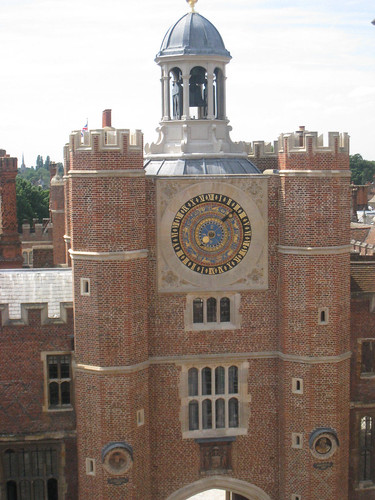"Per signum S. Crucis de inimicis nostris libera nos Deus noster Jesus, Crux, et Maria sint nihi salus, custodia ex via".
10 November 2012
Hampton Court Palace
The site of the Palace was occupied from 1236 by the Knights Hospitaller of Saint John of Jerusalem under the direction of Clerkenwell Priory, the headquarters of the Order in England. The premises at Hampton included some residential buildings, farm buildings, and a chapel. Hampton Court had been a manor in the possession of Sir Walter de St Valery, according to the entry in the Domesday Book of 1086. He went on the First Crusade, and his grandson Reginald de St Valery donated the estate to the Military Order of the Knights Hospitaller. In 1338 a survey was sent by the Prior of Manor of Hampton, to the Master of the Order of the Knights Hospitaller of St. John of Jerusalem concerning their possessions in Hampton and other parts of the country.
The survey provides a good idea of land use in Hampton at that time. The manor house was known as a 'camera' that is to say a small establishment with land.
There were several timber-framed buildings (some with tiled roofs), houses, barns, a chapel and a kitchen with accommodation for visitors and a hall. All were probably arranged around a courtyard. These buildings are thought to have stood on the site of Hampton Court Palace. In the museum at Clerkenwell Priory it is mentioned that one of the sisters of the Order was recorded as a nun of the Hampton religious community who was sent to join others at a new Hospitaller house at Buckland in Somerset. There were probably a few men and women religious at Hampton, and a staff of lay people to work the farm for the benefit of Clerkenwell and the mission of the Order in the Holy Land.
The bell above the astronomical clock (which has only just been repaired) is the oldest existing artefact in Hampton Court Palace, and was cast in the 15th century and once hung over the Hospitallers' chapel. Some human remains found in Chapel Court, north of the present Chapel Royal, are probably those of the Hospitallers or those who worked for them. By the 15th century, some new residential buildings were added to the area of the present Clock Court and used as a country retreat by the Priors of the Order of St John. In 1503, Henry VII and a pregnant Elizabeth of York paid a visit here.
Henry’s Lord Chamberlain, Sir Giles Daubeney, took a 99-year lease on the property and on occasions, entertained Henry VII. It is thought that at this stage the house would have been large and comfortable. If you look at the pavement in front of the colonnade in Clock Court, you can see the layout of Daubeney’s entrance range marked out in brick.
Sir Giles Daubeney died in 1508 and in 1514, Thomas Wolsey obtained a 99-year lease of Hampton Court from the Knights Hospitallers and proceeded to turn the ‘large and comfortable’ country house into a home befitting his status as Cardinal and Lord Chancellor of England.
Subscribe to:
Post Comments (Atom)
Disclaimer
This blog and the opinions are all my own and in no way imply the endorsement from any organization. Nor does a recommendation of another blog or web site imply my agreement or endorsement of everything found on their site.

No comments:
Post a Comment